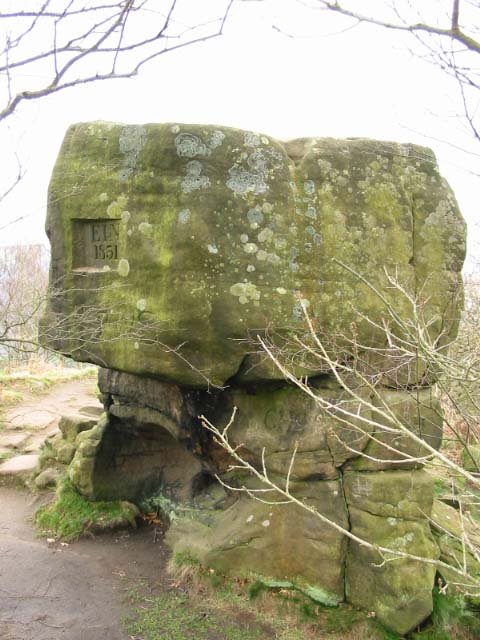An odd shaped barrow that was neither round nor long, nothing remains inside the tree enclosure, in Bramwells ‘Archaeology in the Peak’ he mentions stones of the ruined chambers...didn’t look too hard for them as the place was full of rotting goat(?) carcases.

Inside the enclosure

Ringham Low, enclosure of trees
One of a number of rectangular barrows/cairns in the Harland Edge area, above the Park gate Circle. The shape of the ditch and mound are clearly defined altho’ covered in heather. An oblong of perhaps 8-10 stones, the remains of a cist, sits on its top.

04/02. The ring of stones on top
2 cairns lie in the plantation at Minninglow a massive Neolithic and a smaller Bronze age one, both with exposed chambers.
The Neolithic cairn is still big after much stone robbing, there are four visible chambers a couple with intact capstones, tho’ some of the chambers have been infilled, after some dodgy digging unsettled the place. There may be another chamber still in the remaining mound.
Minninglow can be from miles away, (Five Wells, Bamford Moor). Only when you’re up close to it the hill looks pretty unremarkable.
An excellent place, and no-one goes up there ...that might have something to do with dodgy access rights...
But it’s got to be seen. This is ‘the’ site of The Peak District.

04/03. Open chamber.

04/02
Also known as The Druids Circle. Access is thru Harwood Dale Forest, the stones are in a field on the edge of the plantation. Four Stones were found here with cup and ring markings, now in Scarboro’ museum.

03/02. Whats left of the mound.

03/02

03/02. Near the rock cut armchair on the top of the rocks, a boulder with two ring marks can be seen on the level below.
These two rocks were found by a JCB levelling the school field, They are in a garden at the back of Ashover primary school(unsure about access, ask at the school office). Along with the the stone rows, standing stones and roundhouse erected by the school. Quite mad.
A real Beaut....you’ll not come across owt like it.
When following the Path from Barbrook one, look for the small cairns that sit by the path, there’s an excellent small, restored, kerb cairn on the right hand side of the path before you get to this stone circle.

03/02

03/02 looking toward the MayDay/Lammas sunset
John Barnatt reckoned the circle to have been designed so that it could accurately mark all the major solar and lunar events throughout the calendar.
He suggested the circle had 8 outliers and, using these stones and the cairn above the circle, each event aligned to a landscape feature that marked such an event
In a way, the sad thing is.... Barnatt changed his mind several years later....

03/02. The Bank at the Central Circle

03/02. Entrance to South Circle

03/02. The earthwork avenue leading to Gib Hill.
No ones sure wether this is a ruined or uncompleted henge, or the result of stone quarrying. The Ditches lay just West of Gib Hill.

03/02. Part of Arbor Low II.
Hard to find, after a wade thru’ the heather along Bamford Edge. The circle has no remaing stones, a well preserved bank but averaging only 1ft in height, helping to hide it in the heather.
A small embanked circle and well preserved, although hard to find. It has 4 outliers, one ‘The Old Womans Stone’ was nearly 8 ft tall, only the stump remains upright, after being split, early in the 20Century to stop ramblers using it as a guide stone
Exposed passage and chamber of one of the ‘Peak’ passage graves.
The passage and the grave are both the same width, a curled horned forecourt is still visible( just ). The site is thought to have been robbed since the Romans arrived.
Green Low is on private ground, 50yds away from the footpath.
Great views...except the quarry.

03/02
Recently discovered hillfort. Rock strewned interior, protected by steep drops to the east and south. A boulder wall to the North and West.
The boulder wall uses earthfast boulders in its construction and there are only small sections left.....non of these are overly impressive and its a fair old search to find the sections that remain.
Definitely worth checking out......
----------------------------------------------------------------------------
06/06
John Barnatt has suggested that this hillfort is in fact a ‘causewayed enclosure’ or ‘tor enclosure’ like Gardoms Edge or Carl Wark.
Pre-historic rock carvings have been found on the rocks, although where amongst them all....?

03/02 one of the chimneys on the stride
In the dry stone wall south of the circle once used as a gatepost. May once have been part of the circle.
Head towards the tower from the Gorse Stone, in trees perched right on the edge of the moor
Can be seen from the Southern circle, on the eastern edge of the moor.

03/02 one of the surviving stones, just out of the heather.
About 350-400 yards south of the Central Cirlce, right next to the path. The South Circle is roughly triangular in shape with a few surviving small stones on the internal edge of the bank.

03/02 stones at the southern entrance
Located south of the 9 Ladies, the largest circle on the moor, the only stones lay near the two entrances (N & S), and banking is well preserved.













